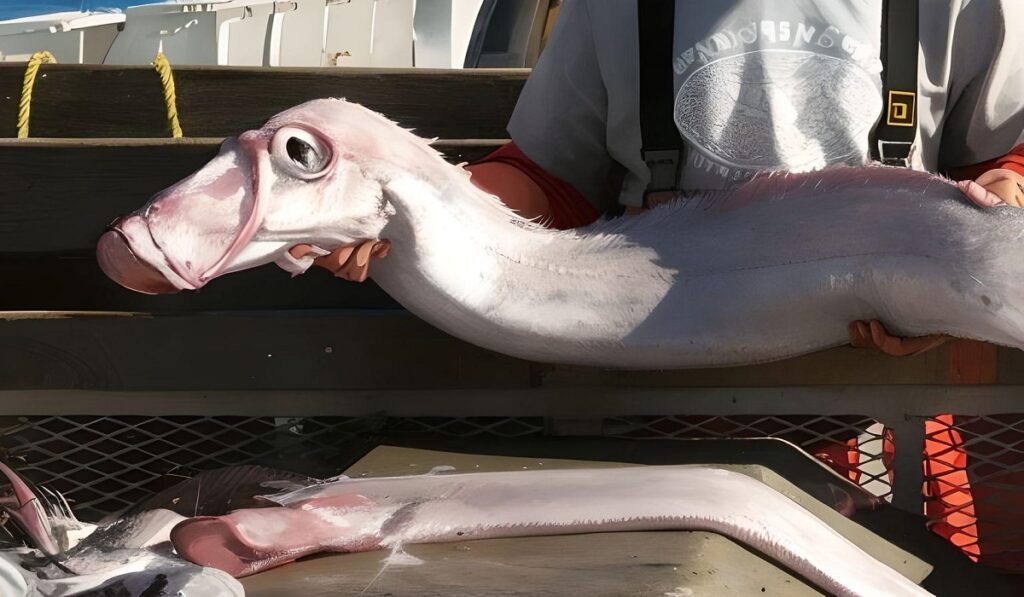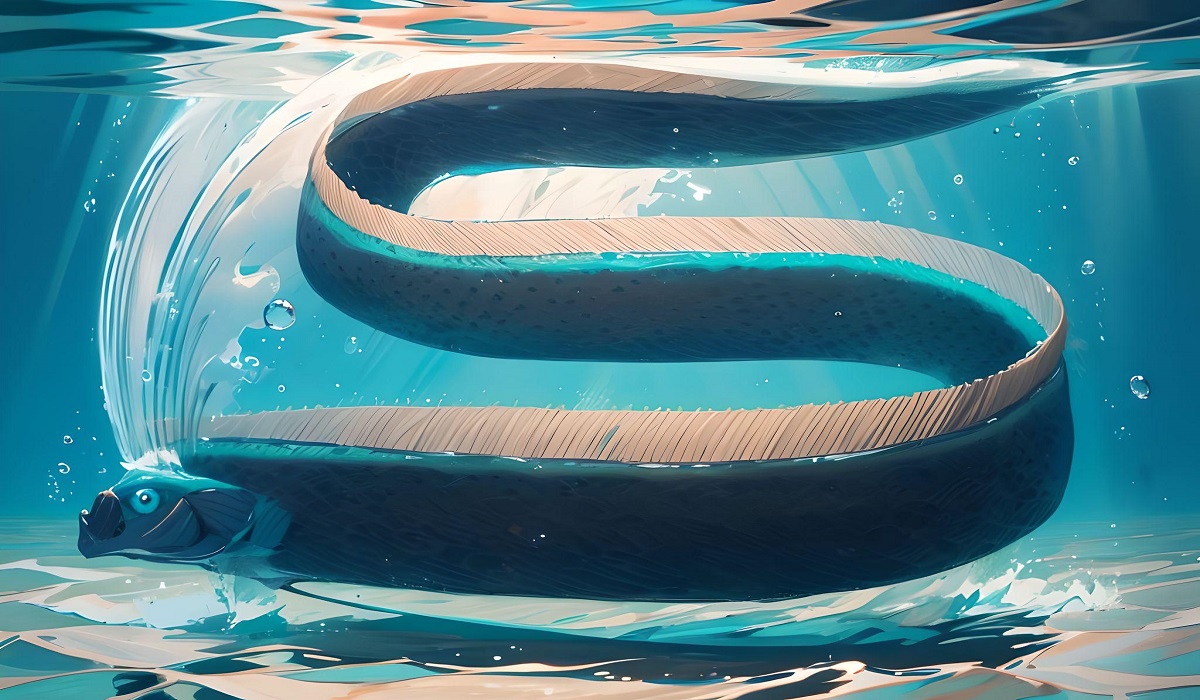Imagine a world beneath the waves, where strange and amazing creatures roam. One such marvel is the Oarfish. With its long, ribbon-like body, it’s like something out of a fairy tale. For ages, people have fascinated about the oarfish, from ancient stories of sea serpents to real-life encounters with these giant fish.
Scientific name: Regalecus glesne
Colour: Shiny silver with red fins
Size: 10-36 feet in length
Weight: up to 300kg
Diet: (Carnivore) Plankton, Crustaceans, and Squid
Lifespan: 10-30 years
Class: Ray-finned fishes
Family: Regalecidae
The giant oarfish is a rare and mysterious creature found in deep ocean waters around the world, including off the coast of Taiwan. These fish possess long, ribbon-like bodies and can grow to impressive lengths, sometimes reaching up to 36 feet or more. While sightings of giant oarfish are infrequent, fishermen in Taiwanese waters occasionally spot them washing ashore or being spotted.
Let’s dive in and learn all about the incredible oarfish – its strange looks, its mysterious habits, and the fascinating tales that surround it. Get ready to be amazed by the wonder of the oarfish, a true marvel of the deep sea. Here are 8 amazing facts about Oarfish-
1) Oarfish is a Guinness World record holder
Oarfish, recognized for their extended, ribbon-like forms, rank among the lengthiest species of bony fish. Oarfish is recorded in the Guinness World books as the World Longest Bony fish. These fish, scientifically termed Osteichthyes, are identified by skeletons that include actual bone, not merely cartilage. While oarfish size are notable, they do not hold the record for weight; that distinction goes to the Sunfish species.
The Oarfish, or Regalecus glesne, stands as the most elongated among the “true” or bony fish. Notably, fishermen captured a 25-foot-long Oarfish that tipped the scales at 272 kilograms near Pemaquid Point, Maine, USA. Additionally, scientists also observed an oarfish estimated to be 50 feet long. Sandy Hook Marine Laboratory found it while swimming near Asbury Park, New Jersey, USA, on July 18, 1963.
2) They are also called as Doomsday fish
The oarfish is a rare and mysterious fish from the deep sea. People have lots of stories and beliefs about it. In Japanese stories, it’s thought to be a sign that something bad like an earthquake or tsunami might happen soon. They call it “Ryugu no Tsuki” or “messenger from the sea god’s palace”. Oarfish come up to the surface when they’re not feeling well, maybe because they’re carried by water currents. That’s why we often find them dead on the shore.
Japanese fishermen found many deep-sea fish around the time a strong earthquake hit Chile in March 2010. Kiyoshi Wadatsumi, an expert on earthquake effects, told the Japan Times that deep-sea fish can sense Earth’s movements better than surface dwellers. Before the 2011 earthquake and tsunami in Japan, about 20 oarfish washed up on beaches in the area, according to Mark Benfield, a researcher at Louisiana State University.
3) Oarfish can self-amputate for protection
Yes, that’s correct. Oarfish are known to possess the ability to self-amputate, or undergo autotomy, of the posterior part of their body. They don’t precisely “self-amputate” in the same manner as certain species like some lizards or insects. This can occur as far forward as the vent, and when it happens, the oarfish loses most of its caecum. Caecum in fishes serves various roles in digestion and absorption, somewhat similar to its function in other vertebrates.
The caecum secretes enzymes that aid in the breakdown of complex food molecules such as proteins, carbohydrates, and lipids. The caecum also plays a role in absorbing water from the undigested food material, helping to maintain proper hydration levels within the fish’s body. This is not a vital organ for the oarfish, so they can survive this self-amputation. This action is believed to be a way to protect oneself from enemies or dangerous animals. Fascinating, isn’t it?
4) Despite their size these fishes are toothless

The oarfish has a highly protrusible oblique mouth that is small in comparison to its body size. Instead of teeth, the oarfish’s mouth is designed to suck in its prey. They are carnivorous but rely on their toothless mouth to capture these tiny organisms. The oarfish feeds by swimming with its mouth open, passively consuming whatever small prey it encounters. They eat tiny animals like plankton, small shellfish, and squid by using special structures called gill rakes in their mouths.
One oarfish found near California had 10,000 krill in its stomach. This passive feeding strategy is effective due to the oarfish’s large size and the abundance of small prey in its deep-sea habitat. The oarfish’s feeding habits play a significant role in the ocean’s ecosystem. By consuming large amounts of plankton, they help regulate the populations of these small organisms, which are a crucial part of the marine food web.
5) Their eggs can float on surface
Oarfish lay eggs in the ocean and release sperm to fertilize them. This usually happens between July and December when the water gets warmer. The eggs float on the water’s surface until they hatch into baby fish, which takes about three weeks. Japanese scientists successfully made baby fish from eggs of two grown-up fish that recently died. This is the first time anyone has seen these fish babies grow from fertilized eggs to young fish in the Lampridiformes family.
It took 18 days for the eggs to grow and hatch in temperatures between 20.5 to 22.5 degrees Celsius. The baby fish, called larvae, looked similar to other young Lampridiformes fish born in the ocean. They usually swam downwards using their side fins and often opened their mouths. This mouth-opening and swimming were signs of their bone development. However, these baby fish didn’t eat anything and died four days after they hatched.
6) Oarfish are dangerous is a myth
Oarfish may seem imposing with their massive size, reaching up to 36 feet long and weighing about 300 kg, but they’re actually gentle creatures. Despite their rare appearances and huge stature, there’s no evidence that they pose any danger to humans. Because oarfish are so big and rarely seen, some people believe they are dangerous sea monsters. However, there’s never been a recorded incident of an oarfish harming anyone.
These long fish typically live deep in the ocean and rarely come near the shore. Their sightings are infrequent, adding to their mysterious reputation as “sea monsters”. Despite their intimidating appearance, oarfish are peaceful animals that peacefully share their habitat with other marine life. In ancient Japan, people thought oarfish might be a sign of earthquakes or tsunamis. These old stories help keep the myth alive that oarfish are mysterious and maybe even dangerous sea monsters.
7) This fish has a sticky jelly-like texture
Due to this sticky jelly-like texture they are not being hunted by fishermen. This texture is primarily due to the composition of their skin and the structure of their body. This slime serves several purposes. Firstly, it provides a layer of protection against parasites and bacteria that may be present in the water. Additionally, it helps to reduce friction as the fish moves through the water, allowing them to swim more efficiently. Furthermore, the slimy coating may also act as a defense mechanism against predators by making it difficult for them to grasp onto the oarfish.
In terms of their body structure, oarfish have long, slender bodies with a ribbon-like shape. This elongated body form contributes to their gelatinous appearance. The combination of their slimy skin and elongated shape gives oarfish a distinctive, jelly-like texture that sets them apart from other fish species. Overall, the sticky, jelly-like texture of oarfish is an adaptation that helps them thrive in their deep-sea habitat. It provides protection, facilitating movement, and contributing to their unique physical appearance.
8) This fish can easily live in dark Deep Ocean
Oarfish live in the deep ocean, mainly in a zone called the mesopelagic zone, which is between 660 feet and 3,300 feet below the surface. This part of the ocean is still mostly unknown to scientists. Their shiny, silver bodies help them blend in with their surroundings, especially when they’re floating vertically in the dark water and light hits them. These fish need specific conditions to survive, like warm water with salt in it, which is why they prefer deep ocean areas.
Oarfish have special features that help them survive in the deep sea:
- They have long bodies that look like oars, which is how they got their name.
- Their dorsal fin runs all along their body and has reddish spots and flaps of skin at the ends.
- Their pelvic and side fins are long, making them look strange and otherworldly.
- Oarfish skin is covered in a shiny substance called Ganoine, which can sometimes glow in the dark.
Oarfish live in various places like the Atlantic Ocean, the Mediterranean Sea, Southern California’s Topanga Beach, and the Eastern Pacific Ocean. They can’t live in freshwater places like rivers or ponds. We’re not exactly sure how long they live, but they can live up to 10 years, depending on where they are.
FAQ’S
1) Are oarfish endangered species?
Oarfish are not officially considered at risk of disappearing forever. But because they live deep in the ocean and are hard to find, it’s tough to know exactly how many of them there are.
2) What was the size of giant oarfish Taiwan?
A really big fish called the oarfish was seen near Taiwan. It was about 6.5 feet long. Even though it wasn’t as big as the largest one ever found, which was 36 feet long, it’s still really cool!
3) What is the size of longest oarfish?
The giant oarfish is the longest-living bony fish ever known. They can grow up to a huge 56 feet long and weigh as much as 600 pounds!
4) Where do oarfish mainly found?
These big fish are hard to find and live in oceans all around the world. They like to hang out in certain parts of the Northern and Southeast Atlantic Ocean, as well as the South Pacific Ocean. They swim really deep, sometimes going down as far as 3,000 feet or even deeper!
Top of Form
5) Do humans eat oarfish?
Some people eat oarfish, but it’s not very usual. Oarfish can be eaten, but most people don’t really want to. Their bodies are long and thin, with lots of tough parts and bones, which makes them not so tasty. Also, their texture is kind of gooey, and not everyone likes that.
6) What do oarfish eat?
Despite being huge, oarfish, those beautiful long creatures living in the deep sea, are actually quite picky eaters. Krill, Plankton, Shrimp, Squid and Small fishes are their main diet.

